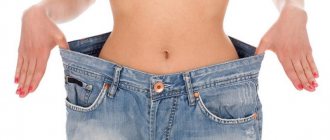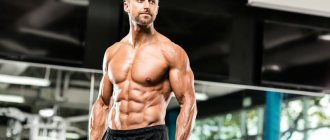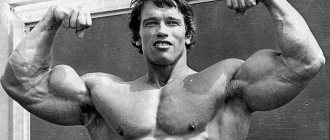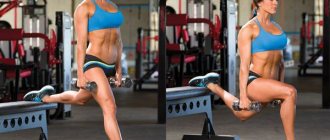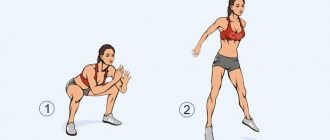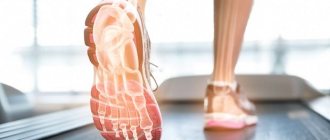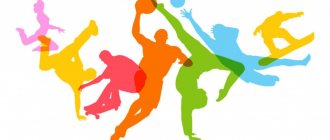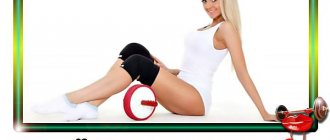Physical exercises performed regularly provide a person with excellent health and a strong immune system. Find out more about the benefits of physical education for children and adults later in the article.
The consequences of physical inactivity and the benefits of physical education
Now let's look at the negative consequences of a sedentary lifestyle and give reasons in favor of physical exercise.
Problems with your figure
Lack of regular exercise leads to the formation of visceral fat, which settles on the hips and waist. Moreover, practice shows that the amount of fat in the absence of movement increases annually by 4-5%. This becomes a serious aesthetic problem, reduces a person’s self-esteem and interferes with living a full life.
Regular physical activity helps improve the situation. By jogging daily, doing aerobics, dancing or swimming, you can lose excess weight, get rid of cellulite, and gain a slim and toned figure without exhausting diets. Taking such care of your body will allow you to have a slim and attractive body, which means increasing your self-esteem and changing your life for the better.
Cardiovascular diseases
The accumulation of fat mass is not only a spoiled figure and aesthetic discomfort. First of all, this is a serious threat to our health, because all internal organs, including the heart and liver, are covered with fat, and cholesterol plaques settle on the walls of blood vessels. All this leads to the development of hypertension, varicose veins, atherosclerosis and other cardiovascular diseases, and also increases the risk of heart attacks and strokes.
When playing sports, the heart muscle is strengthened and the elasticity of the vascular walls is maintained. Moreover, under the influence of physical activity, the amount of “good” cholesterol in the blood increases, while “bad” cholesterol oxidizes and stops sticking to the vascular walls. Physical exercise, according to doctors, leads to a decrease in the level of blood clotting, which reduces the risk of blood clots. Swimming, for example, has a beneficial effect on the human cardiovascular system, increasing its power, efficiency, and vital activity. Regular swimming increases the intensity of blood flow and improves gas exchange in the body.
Thus, physical exercise prevents high blood pressure, prevents varicose veins and minimizes the risk of early mortality from heart failure. According to the American Heart Association, weight lifting exercises are the most beneficial for strengthening the heart and blood vessels.
Diseases of the skeletal system
Physical inactivity also negatively affects bone tissue. Without proper physical activity, bones do not receive the necessary nutrition and gradually weaken. This is the main cause of fractures and the development of osteoporosis in older people. Also keep in mind that excess body weight creates increased pressure on the skeleton, and you will understand where problems with the spine and knee joints come from.
Regular physical activity nourishes and strengthens bones. It is known that when playing sports, bone density will increase. For example, women over 50 who lift dumbbells 3 times a week increase bone density by 1% per year. At the same time, a woman who leads a sedentary lifestyle loses more than 2% of her density per year, which with age leads to increased bone fragility, arthrosis and osteoporosis.
Diabetes
Insulin resistance is a dangerous metabolic syndrome that occurs as a result of obesity. A person who leads a sedentary lifestyle automatically becomes predisposed to diabetes. But this chronic disease leads to multiple dietary restrictions, a serious deterioration in the quality of life and early mortality.
Exercising allows you to normalize weight, prevent obesity and thereby maintain normal blood glucose levels, preventing the development of diabetes.
Amyotrophy
Muscles that do not receive regular exercise gradually weaken and atrophy. Without exercise, muscle mass melts into fat, which means the body cannot function properly. By the way, the heart is an ordinary muscle, which means physical inactivity also affects the blood circulation process.
Physical education solves this problem too. With it, the muscles receive regular load, which means they are in good shape, allowing you to easily perform any task, regardless of age. But more importantly, as a reward you receive a strong heart, which will continue to function without failure even in old age.
Low body tone
It is known that with an active lifestyle, toxins and waste leave the body faster through sweating. In a person with a sedentary lifestyle, this process is slowed down, as a result of which his body becomes polluted. Excessive accumulation of harmful metabolic products leads to decreased tone, constant lethargy, drowsiness, apathy and lack of interest in life.
Regular physical activity gives a person excellent tone and a boost of energy that lasts throughout the day. A person involved in sports does not know what drowsiness and apathy are; he feels great and is in a great mood.
Sleep problems
Insomnia is one of the first signs that clearly hints that you lack physical activity. Poor sleep leads to a deterioration in the quality of life, and if the work involves managing high-risk equipment, it can pose a serious danger to life.
Regular exercise eliminates problems falling asleep and helps fight insomnia. Studies show that people who exercise 30 minutes daily fall asleep 2 times faster and sleep 1 hour longer than people who ignore exercise.
Deterioration of brain activity
As noted above, physical inactivity slows down blood circulation, including the blood supply to the brain. And in this case, brain activity deteriorates, memory begins to fail and mental performance decreases.
To keep your brain active, you need to move more. Physical education improves brain nutrition, activates neural connections and thereby increases mental performance. Walking in the fresh air, cycling or exercises with dumbbells sharpen memory and help the brain cope with complex tasks, which means it is simply necessary for people engaged in mental work.
Weakening of the immune system
The problems that low physical activity creates weaken the body's defenses, as a result of which it becomes susceptible to colds and infectious diseases.
Moderate but regular exercise quickly and effectively strengthens the immune system. Research shows that a person who walks for more than 45 minutes over a 5-day period recovers much faster than someone who ignores walking. Moreover, according to researchers, the beneficial effects of physical activity on immunity can be traced up to 87 years of age. Regular physical exercise promotes the production of macrophages (white blood cells), the so-called “eaters” of pathogens of various diseases. A trained person tolerates various overloads, cooling, fluctuations in atmospheric pressure, infections, and viruses much better.
Early mortality
According to doctors, a sedentary lifestyle is much more dangerous than smoking. Research conducted by scientists from Hong Kong shows the following:
- more than 20% of deaths in people over 35 years of age are associated with physical inactivity;
- lack of physical activity increases the risk of cancer by 45% in men and 30% in women;
- the risk of death from respiratory diseases increases by 62% in men and 55% in women;
- mortality from cardiovascular diseases increases by 53% in men and by 27% in women.
Such depressing statistics are simply bound to make a sane person think about physical education. Moreover, age does not matter for this. This is also proven by a study in which a group of men who regularly received strength and aerobic exercise for 5 years was able to reduce the risk of mortality from diseases by 44%, compared to a group that did not engage in physical exercise.
But solving these problems is far from the only benefit of physical education for humans. By regularly playing sports, a person:
- strengthens the nervous system, copes better with stress and avoids depression;
- it is easier to tolerate existing chronic diseases, hot flashes during menopause and unpleasant symptoms of PMS;
- becomes more self-confident, strives for new discoveries and self-realization, which means he is ready to achieve the greatest heights;
- finds the right balance between work and personal life, learns to manage one’s own time;
- looks 8–10 years younger than his peers;
- gets in a good mood!
Pros and cons of school physical education (and how to get away from physical education)
School physical education is not fashionable fitness; at all times it has not always pleased children. Especially if it was put in front of mathematics or other serious subjects, and you had to drag your skis into the neighboring forest. It’s even more difficult (or easier?) for children who participate in sports clubs from an early age. They already have enough workload, and now they have to jump over a goat. Anastasia Duryagina assessed the pros and cons of physical education.
First grade. Newsletter
Valuable advice and invaluable support for parents of first-graders
My eldest daughter has been doing rhythmic gymnastics since she was five years old and is gradually moving towards serious competitions. Workouts are daily (either at home or in the gym with trainers). I think every child who has been involved in sports since childhood attends their classes with interest and immerses themselves in them headlong, be it boxing, taekwondo, hockey or figure skating.
Author: 15-year-old Zoya
Parental duty is to raise a healthy child
You need to understand that physical activity from sports should not be hard labor for a child. Even if he loves training, and you understand that he is not able to do it, then you need to change tactics.
Younger schoolchildren (7-10 years old) already have access to more intense loads and even exercises to develop muscle strength (squats, push-ups), but only without a load in the form of dumbbells. The main danger of sports activities among younger schoolchildren is the risk of skeletal deformation. Therefore, I strictly monitor my daughter’s health.
Every six months we visit all the doctors at the sports dispensary; without a doctor’s opinion we simply cannot go out on the carpet
At this age, the formation of the skeletal frame is actively underway, so any uneven load (for example, different on the right and left leg) can lead to irreparable curvature of the pelvic bones or spine. Excessive load on the legs (for example, when jumping) can lead to flat feet. So we are monitoring the well-being of the young athlete.
Sports (even amateur) are a serious burden on the heart
This year, my daughter had physical education lessons at school for three days in a row, all of which intersected with her training. They also started trying time trials and assessments. Everything can fail here: nerves, heart, immunity. So we intend to take an official certificate that the daughter plays sports outside of school, and she trains in the gym to best cope with pirouettes, ball, jump rope and hoop on the carpet.
As we managed to find out, attendance at the lesson is mandatory for children who are athletes, but the workload is different. Let's get real about this physical education lesson.
The advantages of physical education at school
- The child will develop physically evenly. Our school provides for going to the pool from the second grade, but for now lessons are being held at the stadium at a comfortable temperature.
- Physical education is primarily a game lesson during which students communicate with each other. Nothing helps improve communication in the classroom like team games or pair exercises.
- School physical education is an opportunity to move around, play outdoor games and warm up without stress. Relevant for athletic children.
Arguments against physical education
- Non-combat losses. Despite precautions and repeated warnings from the teacher, injuries in physical education lessons are simply inevitable. The most common include bruises, sprains and fractures, and you can break a finger simply by catching a ball poorly. For child athletes, such injuries can have serious consequences: both short-term (missing training/competitions) and long-term.
- Any sports activity is a physical activity that is added to the already considerable amount that a child has when combining school and extracurricular activities. Such a snowball of accumulating fatigue can lead to overwork, insomnia and even depression, as well as frequent illnesses, since the child’s body is simply tired.
Freedom certificate
In fact, all the ways to obtain an exemption from physical education for a child athlete come down to one action - negotiate with the school administration, if possible.
For example:
- you can provide the administration with a document from a sports club or school about the child’s attendance at training sessions, their number, schedule and loads that he receives;
- the school can exempt the child from all physical education lessons completely or only from those related to his sport (for example, a biathlete from ski training, a swimmer from swimming lessons);
- during the quarter, the child can bring reports to the physical education teacher on given topics or take the theoretical part;
- the administration may allow the child to come only to test lessons or, conversely, to pass all the standards at the beginning of the year;
- as a compromise, the child can compete for the school in various regional and city sports competitions.
If you are lucky and the administration is favorable towards athletes, then there will be no problems getting an exemption for your child. If the director and teacher are against it, then you will have to make an effort to convince them
The achievements of a little athlete confirmed by medals and diplomas, a letter from a sports club and your own diplomatic skills will help with this. Everything will work out! After all, you are acting in the interests of your child.
Whether your athlete or sportswoman needs an exemption from physical education is a controversial question. On the one hand, it will protect the child from possible injuries and provide an opportunity to use the free time productively, on the other hand, it will deprive some of the benefits. There is no clear answer as to whether school physical education is beneficial or harmful for athletes. Whether it is necessary to abandon it, each parent decides for himself.
In addition, obtaining an exemption is not always easy - sometimes attempts to convince the school administration to comply last for years, in the worst case, escalating into open conflict. Sometimes you even have to make a choice: attend all classes, reduce sports activities, or change school to a more loyal one. This is for an emergency.
The benefits of physical education for children
Physical activity from an early age is the key to good health throughout your life. That is why it is important to instill in children a love of physical education and encourage them to attend sports clubs in every possible way.
During a period of intensive growth, a young body simply needs moderate physical activity. Thanks to physical activity:
- The child's bones and joints are strengthened. The baby receives additional protection against flat feet and has correct posture.
- The immunity of the young body increases. Sports activities also strengthen the body. The child is less likely to encounter influenza and ARVI.
- The child's normal weight is maintained. Sport allows you to avoid the widespread problem of childhood obesity today.
- The baby’s agility and physical endurance increases, and the ability to withstand school stress increases.
- The attentiveness and brain activity of a young schoolchild increases, the scope of knowledge expands, and grades in school improve.
- The tendency to stress and depression decreases, and the child’s self-esteem increases.
The problem of popularizing physical education and sports
The beneficial effects of physical activity on the human body have been confirmed by research, practical observations, and are reflected in numerous proverbs among different peoples of the world.
Both teachers and doctors make a lot of efforts to ensure that society develops a positive attitude towards sports. Educational institutions issue free passes to gyms and swimming pools. These efforts, of course, bear fruit, but the number of people who ignore sports and physical education is quite large.
Sports, of course, are important and necessary for everyone. The main thing is to maintain moderation and avoid overload. We should not forget about the injuries that can occur if safety precautions are neglected.
What physical activity does a person need?
Physical activity is divided into two types: aerobic (cardio) and anaerobic (strength).
Aerobic exercise
These loads are associated with human movement and are used mainly to strengthen the cardiovascular system, improve immunity and combat excess weight. These include walking, running, skiing or cycling, swimming, dancing, aerobics and others.
Anaerobic exercise
As for anaerobic exercises, these include: pull-ups, crunches, sprinting, lifting barbells, exercises with weights and dumbbells. Such loads are good for strengthening and building muscles, preventing diabetes, and also for developing endurance.
Choosing the right exercises
It is worth noting that the benefits of physical education will only appear if a person does it regularly, month after month, year after year. Therefore, it is not so important what type of physical exercise you choose, the main thing is that it brings you pleasure, and you do not lose the desire to play sports.
Do you like running? Start your day with a light jog! Do you love water? Go to the pool three times a week. You can roller skate or bike, do dancing or shaping, aerobics or fitness. Or you can simply take daily walks in the fresh air, the main thing is to do it regularly!
At the same time, studies show that morning physical education classes are the most stable and effective. Immediately after sleep, a person feels alert and rested, his stomach is not full, which means he has much more strength and desire to do physical exercise.
How much do you need to exercise? This question is individual, but on average, if you burn 1000–2000 kcal per week through exercise, this will be quite enough to maintain the health of your body. To achieve such indicators, you can, for example, walk at a speed of 5.5 km/h for 30 minutes every day, or run at a speed of 10 km/h for 20 minutes every day.
Physical development
Technological progress has affected all areas of activity.
The advent of smartphones, computers and other devices has had a significant impact on lifestyle. Working and doing everyday things has become much simpler and easier. This could not but affect a person’s physical activity, which decreased sharply. This situation negatively affects functional abilities and weakens the human musculoskeletal system. Internal organs begin to work somewhat differently, but, unfortunately, the changes are for the worse, not for the better. And since movements are kept to a minimum, a sharply falling level of energy consumption entails disruptions in the muscular, cardiac, vascular and respiratory systems. All this affects the body and health, causing the development of many diseases.
Sport allows you to compensate for the lack of movement and increase energy costs. In addition, in the realities of our time, it is sports and physical education that become the only available ways to be active, allowing us to fill the natural need of each person for a certain amount of exercise and movement.
Physical activity, playing outdoors, and participating in sports activities help build bones and muscles, improve blood pressure, and help keep the child’s weight normal. Active children are less anxious and resistant to stress.
Children who regularly engage in physical education grow strong and avoid many diseases: poor posture, flat feet, scoliosis, bowed legs, bronchitis, gastric disorders and many others.
Good physical shape provides the baby with an attractive appearance, which increases his self-esteem. Participating in games and competitions, receiving prizes and gifts strengthens self-confidence, even if these are ordinary events within a kindergarten group or yard. Fortunately, today it is not difficult to buy cups, awards, and medals.
The skills learned through sports help a child in everyday life because the same principles used in training apply to achieving social goals. Sports children are more persistent, persistent, purposeful, and do not give in to difficulties.
A child who succeeds in sports communicates more easily with other children and leads among his peers. Systematic exercises contribute to the development of certain types of mental activity that are necessary to overcome problems that arise in everyday communication and study. The earlier a child starts playing sports, the more prepared he will be for school life, both physically and intellectually.
